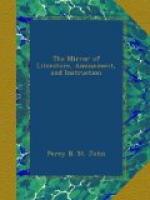And thus they pass, a mournful train,
the “squire,” the “belted knight,”
The “hood and cowl,” the ladies’
page, and woman’s image bright;
In distance now the solemn notes their
requiem’s chant prolong,
And now ’tis hush’d—to
other ears they bear their funeral song.
* * * * *
“Two beauteous sisters, side by
side, their wonted station kept;
The dark-eyed ‘Minna’ look’d
to Heaven, the gentle ‘Brenda’ wept;
Wild ‘Norna,’ in her mantle
wrapp’d, with noiseless step mov’d on,
‘Claud Halcro’ in his grief
awhile forgot e’en glorious ‘John.’
The princely ‘Saladin’ appear’d,
aside his splendour laid,
And only by his graceful mien and piercing
glance betray’d;
The lofty ‘Edith,’ followed
by the silent ‘Nubian slave,’
Dropp’d lightly, as she pass’d,
a wreath upon the poet’s grave.”
* * * * *
THE TOPOGRAPHER.
[Illustration: LESTINGHAM CHURCH.]
LESTINGHAM CHURCH.
(From a Correspondent.)
Lestingham, which is supposed to signify lasting-home, is a village near Kirkby Moorside, Yorkshire, the scene of Buckingham’s death, so caricatured by Pope in his Dunciad. It is remarkable on account of its church, which is a most interesting edifice to the antiquary, exhibiting a true specimen of Saxon architecture. The east end terminates in a semicircular recess for the altar, resembling the tribune of the Roman basilica. It was here that Cedd, bishop of the East Saxons, or London, founded a monastery for Benedictines, about the year 648, or, some say, 655. The church of Lestingham was the first which was built in this district, or the first of which we have any account. It was originally constructed of wood, and it was not till many years after that a stone one was erected.
Cedd was a Saxon missionary, educated at the monastery of Lindisfarne, now Holy Island, not far from Bamburgh, the capital of Bernicia. Ethelwald, king of Deira, knowing Cedd to be a man of real piety, desired him to accept some land for the building of a monastery, at which the king might attend to pray. Cedd availed himself of the proposal, and chose Lestingham. Having fixed on the spot for the site of the sanctuary, he resolved to consecrate it by fasting and prayer all the Lent; eating nothing except on the Lord’s day, until evening; and then only a little bread, an egg, and a small quantity of milk diluted with water; he then began the building. He established in it the same discipline observed at Lindisfarne. Cedd governed his diocese many years; and died of a plague, when on a visit to his favourite monastery at Lindisfarne, where he had been ordained bishop by Finan; he was interred here, 664, but his remains were taken up, and re-interred in the present church, on the right side of the altar.




